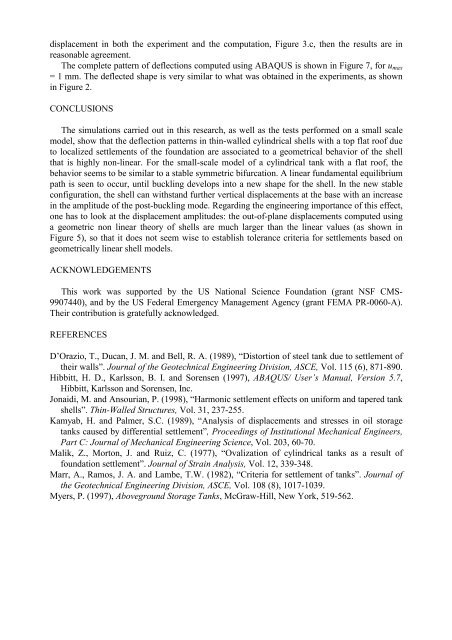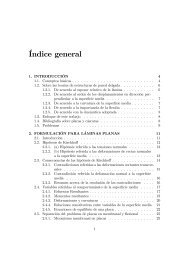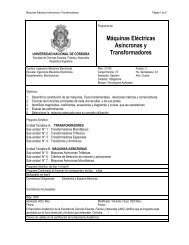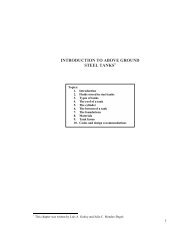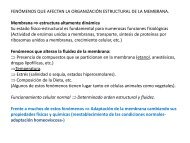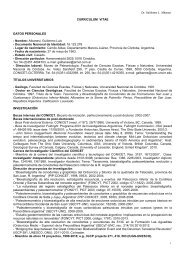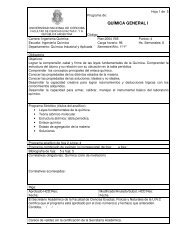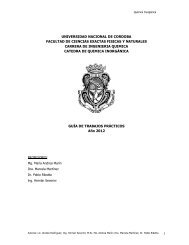Deflections of Thin-Walled Storage Tanks with Roof due to ...
Deflections of Thin-Walled Storage Tanks with Roof due to ...
Deflections of Thin-Walled Storage Tanks with Roof due to ...
You also want an ePaper? Increase the reach of your titles
YUMPU automatically turns print PDFs into web optimized ePapers that Google loves.
displacement in both the experiment and the computation, Figure 3.c, then the results are inreasonable agreement.The complete pattern <strong>of</strong> deflections computed using ABAQUS is shown in Figure 7, for u max= 1 mm. The deflected shape is very similar <strong>to</strong> what was obtained in the experiments, as shownin Figure 2.CONCLUSIONSThe simulations carried out in this research, as well as the tests performed on a small scalemodel, show that the deflection patterns in thin-walled cylindrical shells <strong>with</strong> a <strong>to</strong>p flat ro<strong>of</strong> <strong>due</strong><strong>to</strong> localized settlements <strong>of</strong> the foundation are associated <strong>to</strong> a geometrical behavior <strong>of</strong> the shellthat is highly non-linear. For the small-scale model <strong>of</strong> a cylindrical tank <strong>with</strong> a flat ro<strong>of</strong>, thebehavior seems <strong>to</strong> be similar <strong>to</strong> a stable symmetric bifurcation. A linear fundamental equilibriumpath is seen <strong>to</strong> occur, until buckling develops in<strong>to</strong> a new shape for the shell. In the new stableconfiguration, the shell can <strong>with</strong>stand further vertical displacements at the base <strong>with</strong> an increasein the amplitude <strong>of</strong> the post-buckling mode. Regarding the engineering importance <strong>of</strong> this effect,one has <strong>to</strong> look at the displacement amplitudes: the out-<strong>of</strong>-plane displacements computed usinga geometric non linear theory <strong>of</strong> shells are much larger than the linear values (as shown inFigure 5), so that it does not seem wise <strong>to</strong> establish <strong>to</strong>lerance criteria for settlements based ongeometrically linear shell models.ACKNOWLEDGEMENTSThis work was supported by the US National Science Foundation (grant NSF CMS-9907440), and by the US Federal Emergency Management Agency (grant FEMA PR-0060-A).Their contribution is gratefully acknowledged.REFERENCESD’Orazio, T., Ducan, J. M. and Bell, R. A. (1989), “Dis<strong>to</strong>rtion <strong>of</strong> steel tank <strong>due</strong> <strong>to</strong> settlement <strong>of</strong>their walls”. Journal <strong>of</strong> the Geotechnical Engineering Division, ASCE, Vol. 115 (6), 871-890.Hibbitt, H. D., Karlsson, B. I. and Sorensen (1997), ABAQUS/ User’s Manual, Version 5.7,Hibbitt, Karlsson and Sorensen, Inc.Jonaidi, M. and Ansourian, P. (1998), “Harmonic settlement effects on uniform and tapered tankshells”. <strong>Thin</strong>-<strong>Walled</strong> Structures, Vol. 31, 237-255.Kamyab, H. and Palmer, S.C. (1989), “Analysis <strong>of</strong> displacements and stresses in oil s<strong>to</strong>ragetanks caused by differential settlement”, Proceedings <strong>of</strong> Institutional Mechanical Engineers,Part C: Journal <strong>of</strong> Mechanical Engineering Science, Vol. 203, 60-70.Malik, Z., Mor<strong>to</strong>n, J. and Ruiz, C. (1977), “Ovalization <strong>of</strong> cylindrical tanks as a result <strong>of</strong>foundation settlement”. Journal <strong>of</strong> Strain Analysis, Vol. 12, 339-348.Marr, A., Ramos, J. A. and Lambe, T.W. (1982), “Criteria for settlement <strong>of</strong> tanks”. Journal <strong>of</strong>the Geotechnical Engineering Division, ASCE, Vol. 108 (8), 1017-1039.Myers, P. (1997), Aboveground <strong>S<strong>to</strong>rage</strong> <strong>Tanks</strong>, McGraw-Hill, New York, 519-562.


